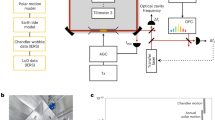Abstract
The determination of high frequency variations in UT-1 and a component of pole position from a single pass of Doppler observations of a Navy Navigation Satellite is affected by instrument errors and uncertainties in the gravity field and atmospheric drag forces used in computing the satellite orbit. For elevation angles above20°, instrument errors contribute about2 msec to the determination of UT-1 and “.03 to the determination of pole position. Gravity and drag errors contribute about 0“.03 of correlated error. But gravity errors may be inferred by statistical analysis of residuuls after drag errors are reduced by drag-compensating devices aboard future Navy Navigation Satellites. Since20 Doppler stations nominally acquire about100 passes each day, daily observations of UT-1 and pole position could achieve precisions of0.2 msec and “.005, respectively, assuming half the passes contribute to the determination of each component of pole position. The current accuracy of Doppler results for two day solutions is about50 cm for pole position and1 msec for high frequency variations in UT-1.
Similar content being viewed by others
References
R.J. ANDERLE: “Determination of Polar Motion from Satellite Observations”,Geophysical Surverys, 1, 147–161, 1973.
R.J. ANDERLE: “Error Model for Geodetic Positions Derived from Doppler Satellite Observations”,Bulletin Géodésique 50, 43–77, 1976.
C. OESTERWINTER: “Polar Motion through 1977 from Doppler Satellite Observations”,Time and Earth's Rotation, 263–278, International Astronomical Union, 1979.
R.J. ANDERLE: “Earth's Rotational Rate”,National Geodetic Satellite Program, 218–219, U.S. Government Printing Office. Washington, D.C., 1977.
D. McCLUSKEY: “Recovery of Plate Tectonic Motion from Satellite Doppler Observations”, Defense Mapping Agency Hydrographic/Topographic Center reprint of report presented to XVII General Assembly of the International Union of Geodesy and Geophysics.
Author information
Authors and Affiliations
Rights and permissions
About this article
Cite this article
Anderle, R.J., Oesterwinter, C. Determination of high frequency variations in earth's rotation from Doppler satellite observations. Bull. Geodesique 54, 544–552 (1980). https://doi.org/10.1007/BF02530712
Received:
Accepted:
Issue Date:
DOI: https://doi.org/10.1007/BF02530712




